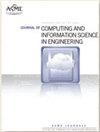HG-CAD: Hierarchical Graph Learning for Material Prediction and Recommendation in CAD
IF 2.6
3区 工程技术
Q2 COMPUTER SCIENCE, INTERDISCIPLINARY APPLICATIONS
Journal of Computing and Information Science in Engineering
Pub Date : 2023-08-23
DOI:10.1115/1.4063226
引用次数: 0
Abstract
To enable intelligent CAD design tools, we introduce a machine learning architecture, namely HG-CAD, that supports the automated material prediction and recommendation of assembly bodies through joint learning of body and assembly-level features using a hierarchical graph representation. Specifically, we formulate the material prediction and recommendation process as a node-level classification task over a novel hierarchical graph representation of CAD models, with a low-level graph capturing the body geometry, a high-level graph representing the assembly topology, and a batch-level mask randomization enabling contextual awareness. This enables our network to aggregate geometric and topological features from both the body and assembly levels, leading to superior performance. Qualitative and quantitative evaluation of the proposed architecture on the Fusion 360 Gallery Assembly Dataset demonstrates the feasibility of our approach, outperforming both computer vision and human baselines, while showing promise in application scenarios. The proposed HG-CAD architecture that unifies the processing, encoding, and joint learning of multi-modal CAD features can scale to large repositories, incorporating designers' knowledge into the learning process. These capabilities allow the architecture to serve as a recommendation system for design automation and a baseline for future work.HG-CAD:CAD中用于材料预测和推荐的层次图学习
为了实现智能CAD设计工具,我们引入了一种机器学习架构,即HG-CAD,该架构通过使用层次图表示对车身和装配级特征进行联合学习,支持装配车身的自动材料预测和推荐。具体而言,我们将材料预测和推荐过程公式化为CAD模型的新层次图表示上的节点级分类任务,其中低层次图捕捉车身几何结构,高层次图表示装配拓扑结构,以及批量级掩码随机化,实现上下文感知。这使我们的网络能够从车身和装配级别聚合几何和拓扑特征,从而获得卓越的性能。在Fusion 360 Gallery Assembly数据集上对所提出的架构进行定性和定量评估,证明了我们方法的可行性,优于计算机视觉和人类基线,同时在应用场景中显示出前景。所提出的HG-CAD架构统一了多模态CAD特征的处理、编码和联合学习,可以扩展到大型存储库,将设计师的知识融入学习过程。这些功能允许体系结构作为设计自动化的推荐系统和未来工作的基线。
本文章由计算机程序翻译,如有差异,请以英文原文为准。
求助全文
约1分钟内获得全文
求助全文
来源期刊
CiteScore
6.30
自引率
12.90%
发文量
100
审稿时长
6 months
期刊介绍:
The ASME Journal of Computing and Information Science in Engineering (JCISE) publishes articles related to Algorithms, Computational Methods, Computing Infrastructure, Computer-Interpretable Representations, Human-Computer Interfaces, Information Science, and/or System Architectures that aim to improve some aspect of product and system lifecycle (e.g., design, manufacturing, operation, maintenance, disposal, recycling etc.). Applications considered in JCISE manuscripts should be relevant to the mechanical engineering discipline. Papers can be focused on fundamental research leading to new methods, or adaptation of existing methods for new applications.
Scope: Advanced Computing Infrastructure; Artificial Intelligence; Big Data and Analytics; Collaborative Design; Computer Aided Design; Computer Aided Engineering; Computer Aided Manufacturing; Computational Foundations for Additive Manufacturing; Computational Foundations for Engineering Optimization; Computational Geometry; Computational Metrology; Computational Synthesis; Conceptual Design; Cybermanufacturing; Cyber Physical Security for Factories; Cyber Physical System Design and Operation; Data-Driven Engineering Applications; Engineering Informatics; Geometric Reasoning; GPU Computing for Design and Manufacturing; Human Computer Interfaces/Interactions; Industrial Internet of Things; Knowledge Engineering; Information Management; Inverse Methods for Engineering Applications; Machine Learning for Engineering Applications; Manufacturing Planning; Manufacturing Automation; Model-based Systems Engineering; Multiphysics Modeling and Simulation; Multiscale Modeling and Simulation; Multidisciplinary Optimization; Physics-Based Simulations; Process Modeling for Engineering Applications; Qualification, Verification and Validation of Computational Models; Symbolic Computing for Engineering Applications; Tolerance Modeling; Topology and Shape Optimization; Virtual and Augmented Reality Environments; Virtual Prototyping

 求助内容:
求助内容: 应助结果提醒方式:
应助结果提醒方式:


